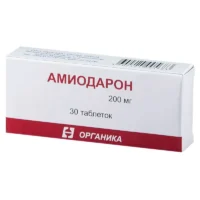Description
Flecainid SAN (Flecainide Acetate) Tablets 100 mg. №30
Composition
Active Ingredient: Flecainide acetate. Inactive ingredients may include lactose, magnesium stearate, microcrystalline cellulose, and colloidal silicon dioxide.
Mechanism of Action
Flecainide acetate is a class Ic antiarrhythmic agent that works by blocking sodium channels in cardiac tissues. This action helps in regulating the electrical activity of the heart, thereby stabilizing irregular heart rhythms.
Pharmacological Properties
Flecainid SAN exerts its pharmacological effects by slowing electrical signals in the heart, which helps in maintaining normal heart rhythm. It is effective in treating various types of arrhythmias, including atrial fibrillation and ventricular tachycardia.
Indications for Use
Flecainid SAN is indicated for the treatment of certain types of irregular heartbeats (arrhythmias) to help restore and maintain normal heart rhythm.
Contraindications
Do not use Flecainid SAN if you have certain heart conditions, such as heart block or a slow heartbeat, without consulting a healthcare provider. It is important to discuss your medical history and current medications with your doctor before starting treatment.
Side Effects
Common side effects of Flecainid SAN may include dizziness, nausea, headache, and changes in heart rate. Serious side effects such as chest pain, shortness of breath, or fainting should be reported to your healthcare provider immediately.
Usage Instructions
Dosage: The usual adult dose is 100 mg every 12 hours. Dosage may vary based on individual response and medical condition. Take Flecainid SAN exactly as prescribed by your doctor. Swallow the tablets whole with a full glass of water. Do not crush or chew the tablets.
Benefits Compared to Analogues
Flecainid SAN offers effective management of arrhythmias with a well-established safety profile. Compared to other antiarrhythmic agents, Flecainid SAN has shown superior efficacy in maintaining normal heart rhythm in patients with atrial fibrillation and other arrhythmias.
Suitable Patient Groups
Flecainid SAN is suitable for adult patients with diagnosed arrhythmias who require pharmacological intervention to stabilize their heart rhythm. It is not recommended for use in children, pregnant women, or individuals with certain pre-existing heart conditions.
Storage and Shelf Life
Store Flecainid SAN in a cool, dry place away from direct sunlight. Keep the tablets in their original packaging to protect them from moisture. Check the expiration date on the packaging and do not use the tablets if expired.
Packaging Description
Flecainid SAN tablets are typically packaged in blister packs to ensure individual tablet integrity and facilitate easy administration. Each pack contains 30 tablets of 100 mg strength.
Clinical Evidence and Proven Effectiveness
Flecainide acetate has been extensively studied for its efficacy in treating various arrhythmias. Clinical studies have shown that Flecainid SAN is effective in maintaining normal heart rhythm in patients with atrial fibrillation and ventricular tachycardia. Research published in reputable journals such as the “Journal of the American College of Cardiology” and the “European Heart Journal” has demonstrated the positive outcomes of using flecainide in managing arrhythmias.





